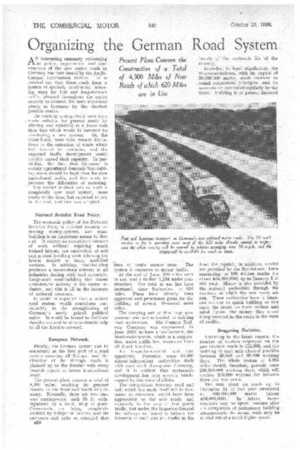Organizing the German Road System
Page 54

If you've noticed an error in this article please click here to report it so we can fix it.
Present Plans Concern the Construction of a Total of 4,300 Miles of New Roads of which 620 Miles
are in Use
A N interesting summary concerning rtthe policy, organization and construction of the new motor roads in Germany has been issued by the AngloGerman Information Service. It is pointed out that these roads form a system of specially constructed motoring ways for fast and long-distance traffic, planned throughout the entire country to connect the most important places in Germany by the shortest possible routes.
The existing system could have been . made suitable for present needs by altering and repairing at a lower cost than that which would he incurred by developing a new system. On the other hand, there were definite limitations to the extension of roads which had existed for centuries, and the expected traffic development would quickly exceed their capacity. In particular, the fact that Germany is mainly agricultural demands that existing roads should be kept clear for slow agricultural traffic, and this tends to increase the difficulties of motoring.
The second method was to build a completely new road system, more costly at the time, but expected to pay in the end, and, this was adopted.
National Socialist Road Policy.
The economic policy of the National Socialist Party is directed towards removing unemployment, and roadbuilding is an important means to that end. It creates an exceptional amount of work without requiring much trained labour, the excavation of soil and general levelling work relieving the labour market of many unskilled workers. In addition, road-building produces a far-reaching activity in all industries dealing with road materials. Large-scale road-building also causes considerable activity in the motor industry, and this is all in the interests of national economy.
It could be expected that a unified road system would contribute considerably to the strengthening of Germany's newly gained political unity. It would be bound to facilitate distribution and be of considerable help to all the districts covered.
European Network.
Finally, the German system can he considered as the first 'part of a road system covering all Europe, and the direction of the through roads is planned up to the frontier with every possible regard to future international roads.
The present plans concern a total of 4,300 miles, reaching its greatest density in the West and South of Germany. Normally, there are two oneway carriageways, each 25 ft. wide, separated by a 17-ft. strip of grass. Cross-roads are being completely avoided by bridges or tunnels, and the entrances and exits so arranged that, B20 lines of traffic cannot cross. The system is exclusive to motor traffic.
At the end of June, 200 miles were in use, and a further 1,234 under construction. The total in use has been increased, since September, to 620 miles. Plans have already been approved and permission given for the building of several thousand more miles.
The carrying out of this huge programme was not entrusted to existing road authorities. The German Railway Company was empowered, in .June, 1933, to form a new concern, the Reithsautobahnen, which is a corporation, under public law, exempted from all direct taxation, An Inspector-General was also appointed. Formerly, some 60,000 almost-independent authorities . dealt with road work throughout Germany, and it is evident that systematic development has been severely handicapped by this state of affairs.
The competition between road and rail, which has made itself felt in Germany as elsewhere, would have been aggravated by the new roads, and especially in the case Of fast •goods traffic, but under the Inspector-General the railways are bound to balance the interests of road and rail traffic to the
benefit of the economic life of the country.
According to legal stipulations, the Reichsautobahnen, with its capital of 50,000,000 marks, must conform to sound commercial principles, and. its accounts are controlled regularly by the State. Building is at present financed from the capital; in addition, credits are provided by the Reichsbank, these amounting to 780 million marks (or about £65,000,000) up to January 1 of this year. Money is also provided by the regional authorities through the territory of which the new roads are run. These authorities have a financial interest in quick building as this eases the strain on their welfare and relief duties, the money thus saved being invested in the roads in the form Of credits.
Staggering Statistics.
According to the latest reports, the number of workers employed on the new German roads is-121,668, and the building of each mile of.road provides between 50,000 and 60,000 working days. The whole system of 4,300 miles should, therefore, provide some 260,000,000 working days, which will employ 260,000 workers for between three and five years.
The sum spent on roads up to December 31 of last year amounted to 696,000,000 marks (about £56,000,000). In future, larger amounts May be spent, because after the completion of preliminary building arrangements the actual work may be carried out at a much higher speed.




























































































